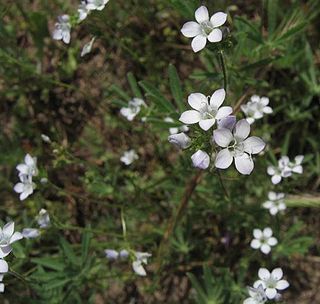
Gilia angelensis is a species of flowering plant in the phlox family known by the common name chaparral gilia. It is native to the coastal hills and mountains of California and Baja California, where it is a member of the chaparral ecosystem., especially in the Transverse Ranges.
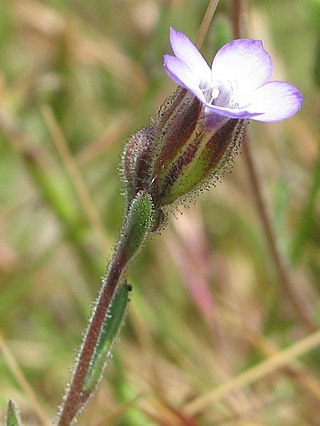
Gilia millefoliata is a species of flowering plant in the phlox family known by the common name manyleaf gilia. It is native to the coastline of Oregon and northern California, where it grows in sand dune habitat.
Gilia ophthalmoides is a species of flowering plant in the phlox family known by the common name eyed gilia. It is native to the Southwestern United States where it can be found in woodlands and high desert plateau.

Arctostaphylos imbricata is a species of manzanita known by the common name San Bruno Mountain manzanita.
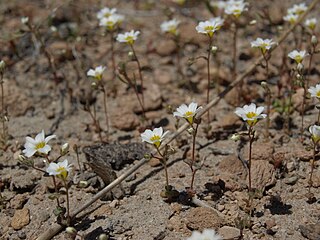
Linanthus inyoensis is a species of flowering plant in the phlox family known by the common name Inyo gilia.
Leptosiphon bolanderi is a species of flowering plant in the phlox family known by the common name Bolander's linanthus.
Linanthus concinnus is a species of flowering plant in the phlox family known by the common name San Gabriel linanthus. It is endemic to the San Gabriel Mountains in the Los Angeles area, where it occurs in dry, rocky habitat in chaparral and forest habitat. This is a small annual herb producing a thin, hairy, glandular stem no more than about 12 centimeters tall. The leaves are divided into narrow, threadlike linear lobes up to 1.5 centimeters long. The inflorescence is a cluster of 3 to 7 funnel-shaped flowers. The lobes of the corolla are up to a centimeter long and white with 2 magenta marks at the base of each.

Leptosiphon grandiflorus is a species of flowering plant in the phlox family known by the common names large-flower linanthus and large flowered leptosiphon.
Linanthus killipii, known by the common name Baldwin Lake linanthus, is a rare species of flowering plant in the phlox family.
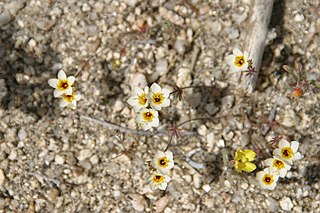
Leptosiphon lemmonii is a species of flowering plant in the phlox family known by the common name Lemmon's linanthus.
Leptosiphon nudatus is a species of flowering plant in the phlox family known by the common name Tehachapi linanthus.

Leptosiphon nuttallii is a species of flowering plant in the phlox family known by the common name Nuttall's linanthus.
Leptosiphon oblanceolatus is a species of flowering plant in the phlox family known by the common name Sierra Nevada linanthus.
Linanthus orcuttii is an uncommon species of flowering plant in the phlox family known by the common name Orcutt's linanthus. It is known only from southern California and Baja California, where it grows in chaparral and pine forests in the Peninsular Ranges and occasionally the San Bernardino Mountains.
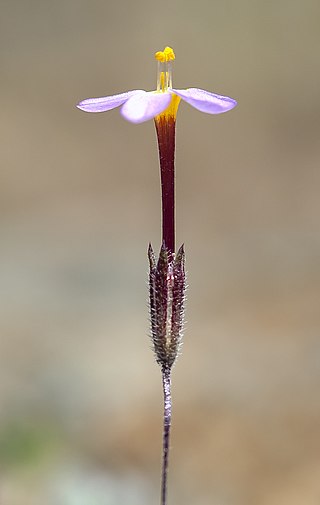
Leptosiphon rattanii is a rare species of flowering plant in the phlox family known by the common name Rattan's linanthus.
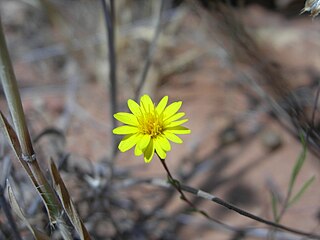
Pentachaeta aurea is a species of flowering plant in the aster family known by the common names golden-rayed pentachaeta, golden chaetopappa, and golden leastdaisy. It is native to southern California, where it grows in the San Gabriel and San Bernardino Mountains and the Peninsular Ranges, and northern Baja California. It is an annual herb with a hairy stem reaching a maximum height near 36 centimeters from a slender taproot. The narrow linear leaves are up to 5 centimeters long but only a few millimeters wide and may be very hairy. The inflorescence is a solitary flower head, with up to 22 heads per plant. The flower head bears many yellow, brownish, or whitish ray florets 3 to 12 millimeters long, and has a center of many five-lobed yellow to reddish disc florets. The fruit is an achene tipped with a pappus of bristles.
Packera bernardina is a rare species of flowering plant in the aster family known by the common name San Bernardino ragwort.
Trichostema micranthum is a species of flowering plant in the mint family, known by the common name smallflower bluecurls.

Eriogonum soredium is a species of wild buckwheat known by the common name Frisco buckwheat. It is endemic to Utah in the United States, where it is known only from Beaver County. There are four populations, all located in the San Francisco Mountains. It is a candidate for federal protection.

Acanthoscyphus is a monotypic genus in the family Polygonaceae that contains the single species Acanthoscyphus parishii, which is sometimes called Parish's oxytheca. This species is native and endemic to southern California.












